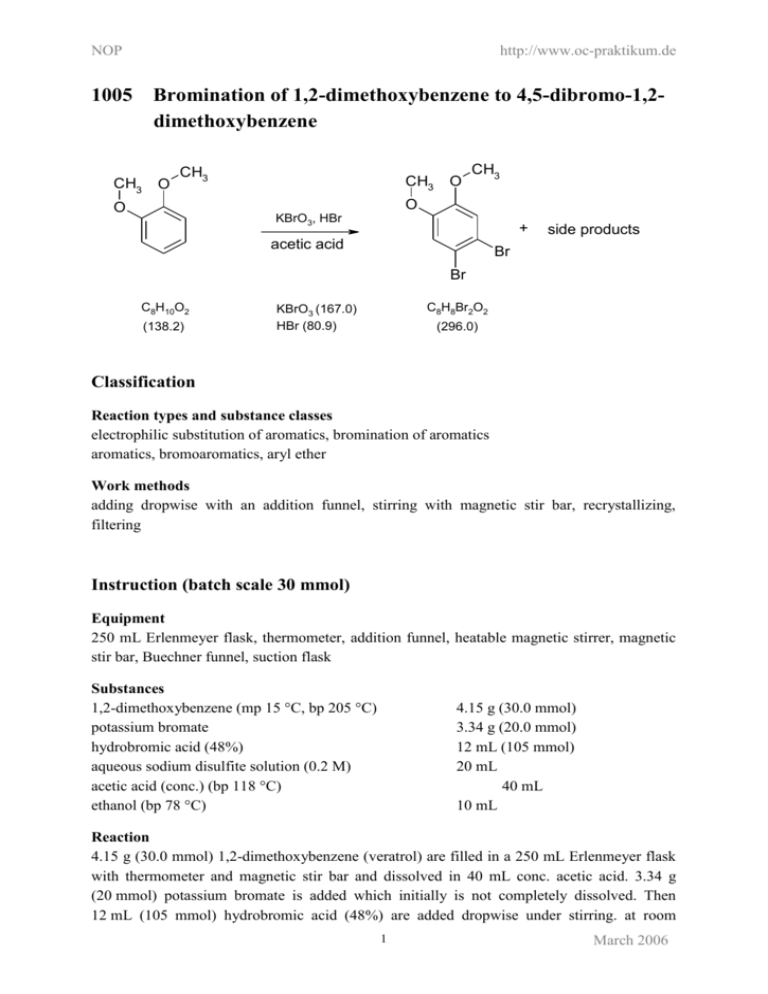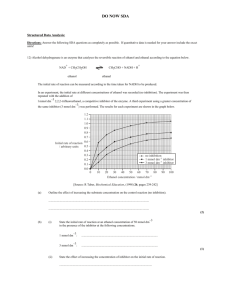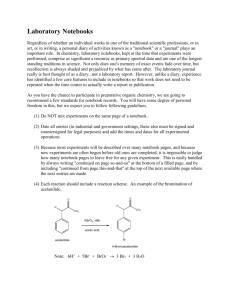- kriemhild
advertisement

NOP http://www.oc-praktikum.de 1005 Bromination of 1,2-dimethoxybenzene to 4,5-dibromo-1,2dimethoxybenzene CH3 O CH3 CH3 O CH3 O O KBrO3, HBr + acetic acid side products Br Br C8H10O2 (138.2) C8H8Br2O2 KBrO3 (167.0) HBr (80.9) (296.0) Classification Reaction types and substance classes electrophilic substitution of aromatics, bromination of aromatics aromatics, bromoaromatics, aryl ether Work methods adding dropwise with an addition funnel, stirring with magnetic stir bar, recrystallizing, filtering Instruction (batch scale 30 mmol) Equipment 250 mL Erlenmeyer flask, thermometer, addition funnel, heatable magnetic stirrer, magnetic stir bar, Buechner funnel, suction flask Substances 1,2-dimethoxybenzene (mp 15 °C, bp 205 °C) potassium bromate hydrobromic acid (48%) aqueous sodium disulfite solution (0.2 M) acetic acid (conc.) (bp 118 °C) ethanol (bp 78 °C) 4.15 g (30.0 mmol) 3.34 g (20.0 mmol) 12 mL (105 mmol) 20 mL 40 mL 10 mL Reaction 4.15 g (30.0 mmol) 1,2-dimethoxybenzene (veratrol) are filled in a 250 mL Erlenmeyer flask with thermometer and magnetic stir bar and dissolved in 40 mL conc. acetic acid. 3.34 g (20 mmol) potassium bromate is added which initially is not completely dissolved. Then 12 mL (105 mmol) hydrobromic acid (48%) are added dropwise under stirring. at room 1 March 2006 NOP http://www.oc-praktikum.de temperature. Potassium bromate dissolves completely, when the temperature of the reaction mixture starts to increase to about 45 °C. The mixture is stirred for further 30 minutes at room temperature. Work up The solution is added to 100 mL ice water and stirred for further 15 minutes. The precipitation is sucked off and washed first with 20 mL of a 0.2 M sodium disulfite solution and then with 20 mL water. Crude yield: 9.2 g The crude product is recrystallized from 10 mL ethanol and dried in the evacuated desiccator over silica gel. Yield: 5.40 g (18.2 mmol, 61%); mp 87 °C Waste management Waste disposal Waste aqueous filtrate mother liquor from recrystallization Disposal solvent water mixtures, containing halogen organic solvents, containing halogen Time 2.5 hours Break Before recrystallization Degree of difficulty Easy Instruction (batch scale 100 mmol) Equipment 250 mL Erlenmeyer flask, thermometer, addition funnel, heatable magnetic stirrer, magnetic stir bar, Buechner funnel, suction flask, rotary evaporator Substances 1,2-dimethoxybenzene (mp 15 °C, bp. 205 °C) potassium bromate hydrobromic acid (48%) aqueous sodium disulfite solution (0.2 M) conc. acetic acid (bp 118 °C) ethanol (bp 78 °C) 13.8 g (100 mmol) 11.2 g (67.1 mmol) 40 mL (350 mmol) 60 mL 133 mL 25 mL Reaction 13.8 g (100 mmol) 1,2-dimethoxybenzene(veratrol) are filled in a 250 mL Erlenmeyer flask with thermometer and magnetic stir bar and dissolved in 133 mL conc. acetic acid. 11.2 g 2 March 2006 NOP http://www.oc-praktikum.de (67.1 mmol) potassium bromate are added which initially is not completely dissolved. Then 40 mL (350 mmol) hydrobromic acid (48%) is added dropwise under stirring at room temperature. Potassium bromate dissolves completely when the temperature of the reaction mixture starts to increase. The solution ist stirred for further 30 minutes at room temperature. Work up The reaction mixture is addedd to 200 mL ice water and stirred for further 15 minutes. The precipitation is sucked off and washed first with 60 mL of a 0.2 M sodium disulfite solution and then with 100 mL water. Crude yield: 32.7 g The crude product is recrystallized from 20-25 mL ethanol and dried over silica gel in the evacuated desiccator. Yield: 23.0 g (77.7 mmol, 78%); mp 87 °C; GC-purity 100% Comments By evaporating of the solvent from the mother liquor at the rotary evaporator and recrystallization of the residue from ethanol, a small amount of a second less pure crystall fraction can be isolated. The remaining mother liquor contains mainly the side product 4-bromo-1,2-dimethoxybenzene (see analytics). Waste management Recycling The ethanol is evaporated from the mother liquor, collected and redistilled. Disposal Waste aqueous filtrate residue after evaporation of the ethanol Disposal solvent water mixtures, containing halogen organic solvents, containing halogen Time 3 hours, without recrystallization and drying Break Before recrystallization Degree of difficulty Easy Instruction (batch scale 1 mol) Equipment 4 L Erlenmeyer flask, thermometer, addition funnel, heatable magnetic stirrer, magnetic stir bar, Buechner funnel (large), suction flask, 1 L beaker, 2 L beaker, ice bath, rotary evaporator Substances 1,2-dimethoxybenzene (mp 15 °C, bp 205 °C) 138 g (1.00 mol) 3 March 2006 NOP http://www.oc-praktikum.de potassium bromate hydrobromic acid (48%) sodium disulfite solution (0.2 M) conc. acetic acid (bp 118 °C) ethanol (bp 78 °C) 112 g (0.671 mol) 400 mL (3.5 mol) 600 mL 1.3 L 200 mL Reaction 138 g (1.00 mol) 1,2-dimethoxybenzene (veratrol) is filled in a 4 L Erlenmeyer flask with thermometer and magnetic stir bar and dissolved in 1.3 L conc. acetic acid. 112 g (0.671 mol) potassium bromate is added, which initially is not completely dissolved. Then 400 mL (3.5 mol) hydrobromic acid (48%) is slowly added dropwise under stirring at room temperature. At a temperature increase to 60 °C and change in colour of the solution from yellow to brown the addition is interrupted and the solution is cooled down with an ice bath to room temperature. Then the remaining hydrobromic acid is added faster. After complete addition the mixture is stirred for 1 further hour at room temperature. Work up The reaction mixture is added to a 2 L beaker filled with 1000 mL ice water and stirred for 30 minutes. The precipitation is sucked off, filled in a 1 L beaker with 600 mL of a 0.2 M sodium disulfite solution and washed. The precipitation is sucked off again, washed in a 1 L beaker with 800 mL water and sucked off again. Crude yield: 339 g The crude product is recrystallized from 200 mL ethanol. The product is dried in the evacuated desiccator over silica gel for some days until reaching weight constancy. Yield: 271 g (916 mmol, 92%) 4,5-dibromine-1,2-dimethoxybenzene; mp 87 °C Comments By evaporating the solvent from the mother liquor and recrystallization of the residue from ethanol a second less pure crystall fraction can be isolated. The remaining mother liquor contains mainly the side product 4-bromo-1,2-dimethoxybenzene (see analytics). Waste management Recycling The ethanol is evaporated from the mother liquor, collected and redistilled. Waste disposal Waste aqueous filtrate residue after evaporation of the ethanol Disposal solvent water mixtures, containing halogen organic solvents, containing halogen Time 1 day without recrystallization and drying 4 March 2006 NOP http://www.oc-praktikum.de Break Before recrystallization Degree of difficulty Medium (not easy because of the large volume of substances) Analytics GC GC conditions: column: inlet: carrier gas: oven: detector: integrator: 5CB Low Blend/MS, length 30 m, internal diameter 0.32 mm, film 0.25 µm injector temperature 210 °C, splitinjection, injected volume 1 µL H2, pre-column pressure 50 kPa 60 °C (2 min), heating rate 10 °C/min, isotherme 240 °C (50 min) FID, 310 °C Shimadzu Percent concentration was calculated from peak areas. GC of the crude product Retention time (min) 14.9 11.2 GC of the pure product Substance 4,5-dibromo-1,2-dimethoxybenzene 4-bromo-1,2-dimethoxybenzene Educt veratrol (retention time = 6.4 min) is not detected. In the pure product side products are detectable only in traces. 5 March 2006 NOP http://www.oc-praktikum.de GC of the second crystal fraction Retention time (min) 15.1 11.4 Substance Peak area % 4,5-dibromo-1,2-dimethoxybenzene 4-bromo-1,2-dimethoxybenzene 98.3 1.6 GC of the remaining mother liquor Retention time(min) 15.0 11.4 Substance 4,5-dibromo-1,2-dimethoxybenzene 4-bromo-1,2-dimethoxybenzene 6 Peak area% 29.4 66.7 March 2006 NOP http://www.oc-praktikum.de 1H NMR spectrum of the crude product (400 MHz, CDCl3) 1H NMR spectrum of the pure product (400 MHz, CDCl3) (ppm) 3.85 7.05 CH3 Multiplicity S s Number of H 6 2 Assignment CH3 3-H, 6-H O 2 1 6 CH3 O C C 3 C C 4 C 5 C Br Br 7 March 2006 NOP 13C http://www.oc-praktikum.de NMR spectrum of the pure product (400 MHz, CDCl3) (ppm) 56.14 114.62 115.78 148.74 76.5-77.5 Assignment CH3 CH3 O C-4, C-5 C-3, C-6 2 1 6 C-1, C-2 solvent CH3 O C C 3 C C 4 C 5 C Br Br IR spectrum of the pure product (KBr) (cm-1) 3100 - 3000 2840 1585 Assignment C-H-valence, arene C-H-valence, alkane C=C-valence, arene 8 March 2006







